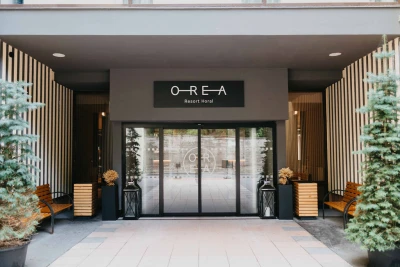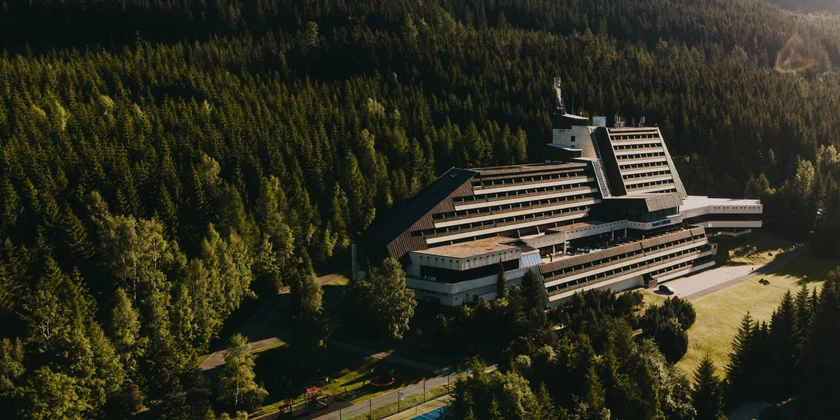Sněžka
Sněžka is the highest mountain on the Silesian border as well as the whole of Bohemia (1603 m).
Elbe spring
The so-called ‘Elbe spring’ centred with a concrete ring, lies at an altitude of 1386 meters.
Monument to victims of the mountains
A symbolic monument to the victims of the mountains was established in a former small chapel 1957 in the lowland (1510 m) in Luční sedlo (also Modré sedlo), between the Luční and Studniční mountains.
The Elbe dam
The dam was built between 1910 – 1914.
Luční bouda (Meadow chalet)
The largest chalet in Krkonoše (the Giant Mountains) on Bílá louka (White meadow) is situated at the edge of Úpské rašeliny (Úpa peat bog) (1400 m).
Obří důl (Giant mine)
A massive valley of glacial origin stands between the foot of Sněžka and Pec pod Sněžkou.
Údolí Bílého Labe (White Elbe valley)
Divoké údolí (the Wild Valley – 800-1420 meters) was formed by the erosion of glacial origin, which was 6.5 km long.
Hanč and Vrbata memorial
The Memorial over Vrbata chalet on Zlaté návrší (Gold Hill).
Kotelní jámy (Kettle pitts)
This is a protected area (101 hectares) formed by the glacial cirques ”Velké a Malé Kotelní jámy” (Big and small kettle pits), separated by the rocky ”Liščí hřebínek” (Fox’s ridge. The Big Boiler Pit is recessed in granite and the small pits are recessed in mica schist crystalline metamorphic rock. The pits were mined for copper ore. The area contains varied mountain flora. There are slopes prone to avalanches, and is therefore in winter the trail is impassable.
Sněžné jámy (Sněžné pits)
It is the most mighty kar in Krkonoše (the Giant Mountains), just across the border on Polish territory (1480 m) on the border ridge, about 500 meters from the top of Vysoké kolo. The massive kar originated from deep glacier erosion, and frost weathering on the rock walls. The kar consists of two parts -Malé a Velké Sněžné jámy (Small and Big Snow Pits) separated by a rocky spur. The perpendicular granite walls are about 200 m high and at the bottom are glacial lakes called ‘Kochelské rybníčky (‘Kochelské ponds)’. The entire territory of the Snow Pits is a nature reserve.
Labský vodopád (The Elbe waterfall)
The Elbe waterfall falls from The Elbe chalet to the Elbe gorge into the Elbe Valley. It is 50 m high and the rocks fall a further 250 m to the bottom of the mine. In the past, it was a mighty waterfall and thanks to J. Šíra the owner of The Elbe chalets who built a small reservoir this now allows groups of tourists to see the waterfall. Today, the waterfall has a more cascading nature.
Pančavský waterfall
This is the highest waterfall in the country. It is 250 m high, divided by several levels. In the Pančavská pit is the Schustler garden (which is inaccessible), which grows 150 kinds of vascular plants. The garden is named after the Czech scientist Professor. F. Schustler, who designed the Krkonoše National Park in Prague in 1923.
Malý rybník (Maly Staw – Little pond)
The mountain lake (1183 m), is also called ‘Malý stav’ or ‘Malý rybník’ (‘Little state’ or ‘Little Pond’) on the Polish side of the Giant Mountains under the Czech-Polish friendship pathway.. The lake was created by the movement of an iceberg, it is 241 m long and 166 m wide, the depth is 7 m. The lake holds water up to 60 m high due to a moraine granite dam edge. The river flows out of the lake Velká Lomnice (Big Lomnice),. At the east of the lake an avalanche fell on 20th of March 1968 which killed 19 people.
Velký rybník (Wielky staw – Big pond)
It is a glacial lake (1225 m), which has a depth of up to 25 meters, and its size is 6.5 hectares. The Žulová lake wall is 180 m high. At the bottom of the lake at a depth of 2-5 m a rare aquatic fern called quillwort grows. It is inaccessible from the Czech-Polish friendship pathway.




